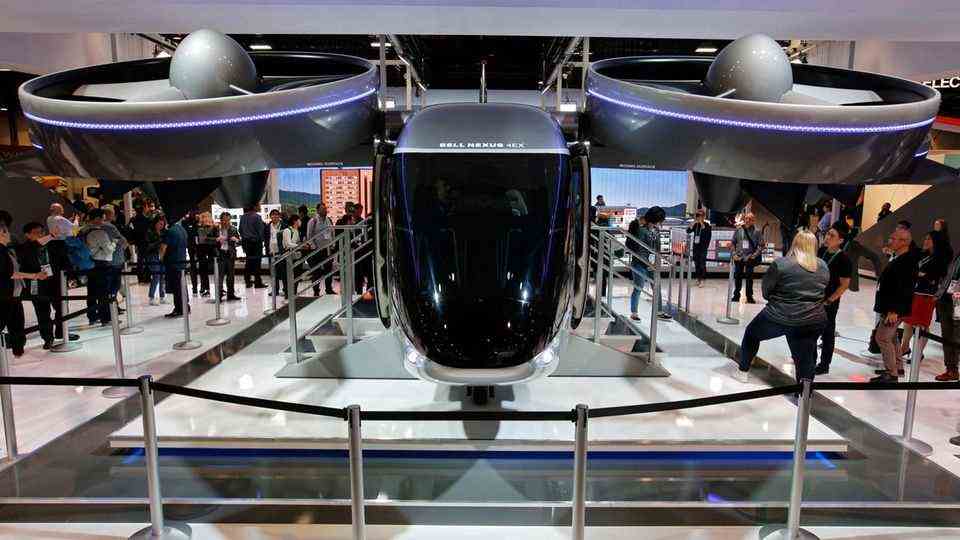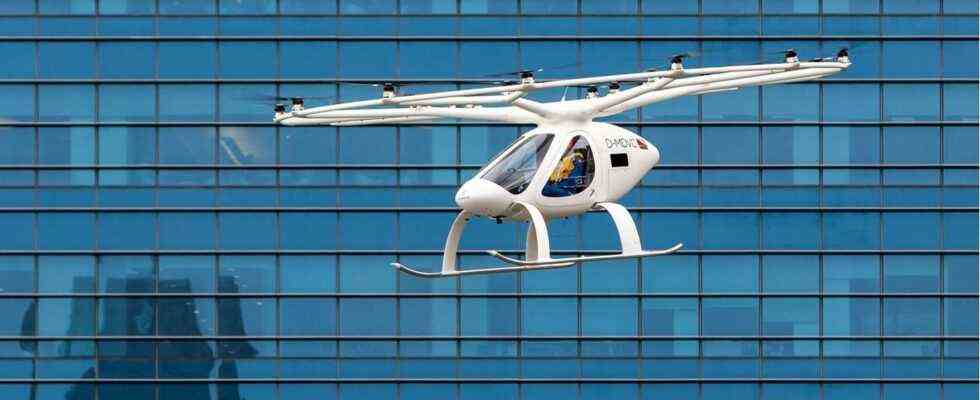Study on vertical mobility
Will air taxis become the urban means of transport of the future?
The 2.3 ton air taxi model “CityAirbus” is back on the ground after a test flight.
© Peter Kneffel / Picture Alliance
There are dozens of projects around the world that deal with vertical mobility. The first electric air taxis have already taken off. Billions are invested in start-ups. A study took a closer look at the hype surrounding air taxis.
It is the latest dream of flying: Instead of getting around the city by taxi, you take off and use an emission-free air taxi. Sitting in the next generation of flying vehicles, any traffic jam is overflown in a few minutes. It is no longer powered by fossil fuels, but by sustainably generated electrical energy.
In cities like SãoPaulo, managers are already moving between high-rise buildings and suburbs in helicopters that land on the roofs of the skyscrapers. Will the next generation of flying taxis replace the helicopter and become a means of transport that not only the upper class can afford? Can air taxis make an important contribution to getting the traffic problem in densely populated metropolises under control?
This and the question of whether the investments in the new technology companies will be profitable is what a team of authors from the management consultancy Porsche Consulting asked itself in the study “The Ecoconomics of Vertical Mobility”.
Urban mobility of tomorrow
The still young market for aircraft under the collective term eVTOL, the acronym from “electric vertical take-off and landing aircraft”, has recently been experiencing a boom. US $ 5.5 billion has flowed into companies in the past six years, fueled by the initial public offerings of some investment companies.
One of the players in the market is the Munich-based company Lilium, which is developing a seven-seater and has already received a preliminary contract for 220 copies from the Brazilian airline Azul. The company Volocopter is based in Bruchsal near Karlsruhe and in Singapore. In addition to cargo drones, it also has the VoloCity aircraft for passengers, which can fly, take off and land autonomously.
The first flying taxis are already taking off
14 images
The Californian start-up Archer wants to complete a mixture of airplane and helicopter by 2024. United Airlines relies on the whiz kid Archer Marker. The airline has options for 200 copies to transport passengers between airports and urban centers quickly, more quietly and much more cheaply than by helicopter.
In the Far East, corporations such as Toyota and Hyundai are developing the new means of transport. Aircraft manufacturers such as Boing and Airbus are involved in corresponding projects. The eight-rotor CityAirbus with four fixed drive nacelles has already completed test flights and will be replaced by the CityAirbus NextGen, which is scheduled to start in two years.
New infrastructure required
“The range is still determined by the current battery technology,” says the study. In terms of technology, many air taxi projects will be implemented by the middle of the decade. Only from 2035 could the new means of transport develop into an “over the air”.
More than half of the estimated $ 25 billion investment will go into hardware development. In addition, up to 40 percent must be taken into account for the corresponding infrastructure on the ground.

“The infrastructure is the possible Achilles heel – both the construction and expansion, as well as the capacity,” says Gregor Grandl from Porsche Consulting in an interview with the star. In contrast to helicopters, electric air taxis also require their own charging stations. All manufacturers have to agree on a standard. “It will take time to set up take-off and landing sites,” says Grandl. “For example, it is technically complex to retrofit the existing high-rise buildings with connection lines for electricity.”
The study concludes that “technology enables vertical mobility, but broad social acceptance will make it relevant.” The decisive factor is how much noise from air taxis will be. “Social acceptance is crucial for the approval of locations,” says Grandl.

Surrounded by the stand in January 2020 in Las Vegas: The Bell Nexus 4EX Hybrid Electric Air Taxi.
© John Locher / Picture Alliance
Further challenges are the approval procedures required for aircraft. The US aviation authority FAA and EASA in Europe have to accept the design and technology, which can take years. The airspace surveillance is also likely to be reorganized in order to coordinate the air taxi volume with the rest of the air traffic in the future.
“A subway has more than 10 times the capacity”
In this industry, investors have to have staying power for at least 15 years before the emission-free air taxi has established itself as another means of transport. Test routes are already being planned in the first cities. In addition to Singapore, Dallas and Dubai, this also includes Guangzhou, Melbourne and Los Angeles.
The new means of transport will initially move little. “For each take-off and landing point, I expect an initial capacity of well under 100 passengers per hour,” says Grandl. “In comparison: around 3,000 people per hour move in one lane of a street today, and an underground train has a capacity more than 10 times that.”
In the long term, however, “vertical mobility could develop into a lucrative niche and air taxis could become as normal as taxis,” said Grandl. However, air taxis will not solve mankind’s traffic problems either, since their development and market success are fraught with considerable risks and technical and economic barriers. “The market development is still uncertain. Building the ecosystem of aircraft, infrastructure and air taxi services could take significantly longer than some investors think.”


